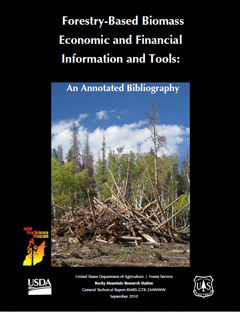Displaying 121 - 140 of 188
Clark, Saucier
ANNOTATION: This article has tables and equations for estimating total-tree weights, stem weights, and volumes of plantation-grown loblolly, and slash when DBH and height to a four inch top or total height are known.
Year: 1990
Type: Document
Source: FRAMES
Baughman, Stokes, Watson
ANNOTATION: A tub grinder was employed to process debris discharged by a flail. The machine successfully passed the material through a 7.62 cm screen and discharged the reduced debris into a chip van for transport. It was found that fuel production is…
Year: 1990
Type: Document
Source: FRAMES
Lambert
ANNOTATION: This paper addresses the imbalance of unused resources, costs of on-site fuel treatment, electrical power demands, technology and economic deficiencies in harvesting and transportation, and the shrinking average size of trees being harvested.…
Year: 1989
Type: Document
Source: FRAMES
Johnson
ANNOTATION: At the time of this paper, it was found residue recovery operations in the intermountain region were mostly experimental, as mill residue supplies were adequate for hogfuel demand. However it was recognized that future wood fiber supplies and…
Year: 1989
Type: Document
Source: FRAMES
McMinn, Clark
ANNOTATION: Seven areas in Georgia were harvested with a conventional system and three with a whole tree system. Pre- and post-harvest sampling of all standing woody biomass provided base data for estimating standing and downed residuals by initial stand…
Year: 1989
Type: Document
Source: FRAMES
Stephenson
ANNOTATION: This paper provides an overview of the concept, development, and technology of flail debarkers.
Year: 1989
Type: Document
Source: FRAMES
Hartsough
ANNOTATION: At the time of this paper, most forest residues were too expensive to recover, but some materials were being chipped at the roadside. This paper describes biomass-powered generating facilities and the sources of materials for the plants in…
Year: 1989
Type: Document
Source: FRAMES
Stokes, Sirois
ANNOTATION: In the mid 1970's, the accelerated price increases for petroleum products forced rapid exploration into and adoption of alternative energy sources. A viable option for the forest industry was the recovery of woody biomass from unmerchantable…
Year: 1989
Type: Document
Source: FRAMES
Sturos, Thompson
ANNOTATION: This paper presents an overview of several harvesting machines and systems considered new at the time this paper was produced. The systems were being applied in the hopes of improving profitability from harvesting small stems and residues.…
Year: 1989
Type: Document
Source: FRAMES
Watson, Stokes
ANNOTATION: Operations that harvest small stems using conventional equipment are discussed. A typical operation consists of rubber-tired feller-bunchers with shear heads, rubber-tired grapple skidders, and in-woods chippers. These systems harvest the…
Year: 1989
Type: Document
Source: FRAMES
Young, Ostermeier, Mulach, Thomas, Brooks
ANNOTATION: A harvesting simulation model was developed to estimate average total costs of whole-tree chip harvesting as a function of equipment configurations and stand characteristics. The harvesting simulation model was part of a larger economic model…
Year: 1989
Type: Document
Source: FRAMES
Edman
ANNOTATION: This paper provides a brief history of the development of a system to economically thin overstocked, naturally seeded stands in the Pacific Northwest. It also provides a comparison of flail debarking efficiency in the woods with small alder…
Year: 1989
Type: Document
Source: FRAMES
Brinker, Tufts
ANNOTATION: This paper provides a general overview of chipping wood for pulp and energy wood including fuel chip production costs, problems, innovations, and system designs.
Year: 1989
Type: Document
Source: FRAMES
McMinn, Clark
ANNOTATION: This paper describes how in a mixed pine-hardwood stands in central Georgia, the tonnage of all trees not designated for harvest accounted for 89% of the variation in tonnage of standing residuals after conventional harvesting. Standing…
Year: 1988
Type: Document
Source: FRAMES
Miller, Straka, Stokes, Watson
ANNOTATION: In this study, conventional harvesting equipment was tested for removing forest understory biomass for use as fuel. Two types of systems were tested--a one-pass system and a two-pass system. In the one-pass system, the energywood and pulpwood…
Year: 1987
Type: Document
Source: FRAMES
Puttock
The economics of collecting and processing whole-tree chips and logging residues (slash and residual timber) for energy use have been compared using data collected from four timber harvesting operations. The fuel cost of energy from these sources was…
Year: 1987
Type: Document
Source: FRAMES
Stokes, Sirois, Woodfin
ANNOTATION: A round hay baler with little modification was used to bale small-diameter, crushed trees. The trees had been crushed using a series of compression rollers. Bale cores had to be developed by hand before the baler became self-feeding. Windrowed…
Year: 1987
Type: Document
Source: FRAMES
Stokes, Watson, Sirois
ANNOTATION: This study was performed to evaluate some of the factors affecting the power requirements for chipping whole trees in the South for energywood. Results are presented for the effects of tree size, moisture content, and species on power…
Year: 1987
Type: Document
Source: FRAMES
Watson, Miller, Stokes, Broussard
ANNOTATION: The fuel and energy requirements for alternative energywood harvesting operations were determined from field operations. Comparisons were made among the total energy requirements including transportation for conventional operation and one- and…
Year: 1987
Type: Document
Source: FRAMES
Watson, Ragan, Straka, Stokes
ANNOTATION: This paper compares fuelwood produced from logging residues and energy plantations on the basis of potential for production and expected costs at the various levels of production. Prospects for improving the production of fuelwood for each…
Year: 1987
Type: Document
Source: FRAMES

